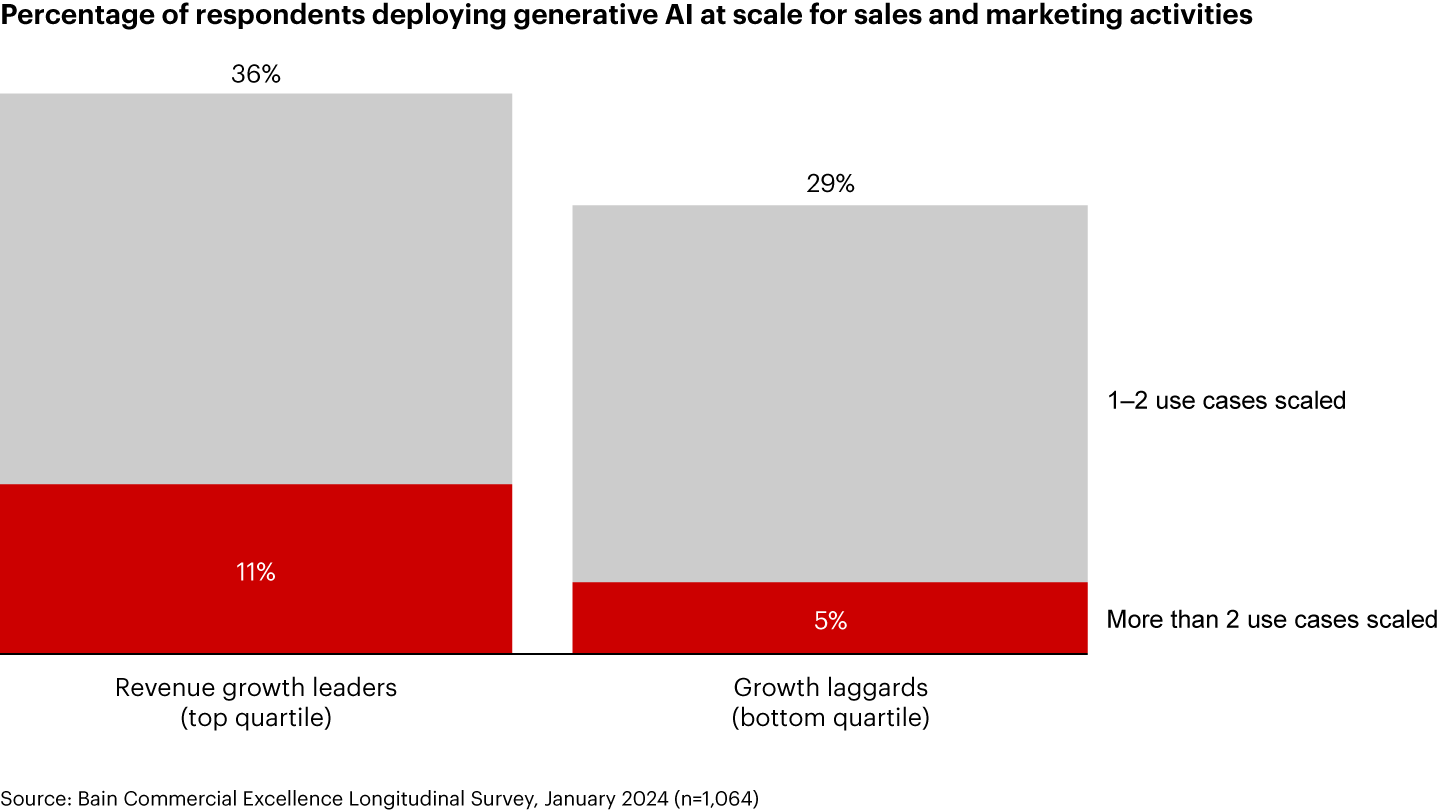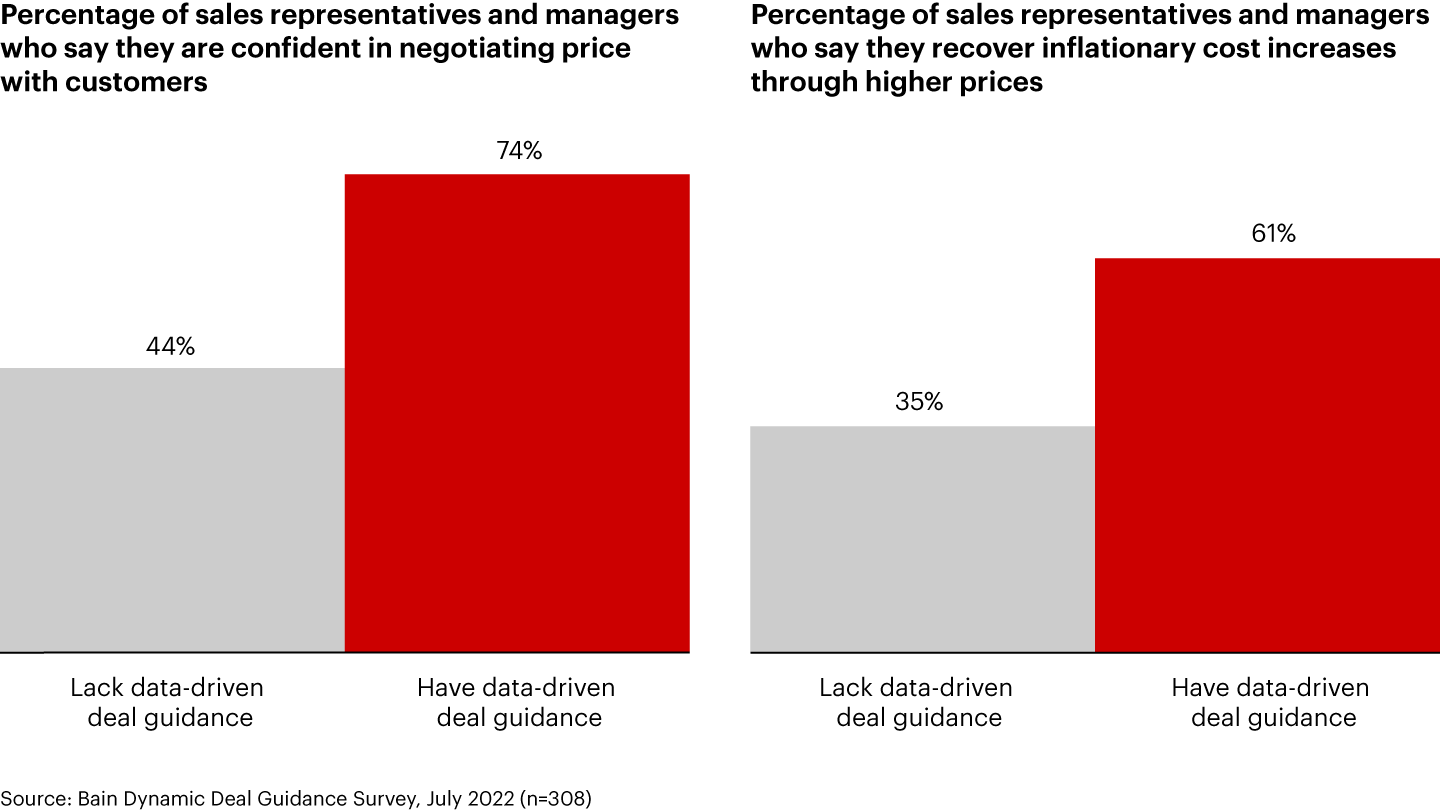Brief

Executive Summary
- As companies start to apply generative AI to pricing, those in the top quartile for revenue growth deploy the technology twice as often as growth laggards.
- AI is already improving price-setting models, supporting real-time price adjustments, and informing smarter contract negotiations.
- The shift to AI-supported pricing requires building intelligent pricing organizations by investing in data, infrastructure, talent, and training.
Many companies are keen to apply artificial intelligence to the pricing realm, as a way to accelerate both growth and profitability. However, plenty of challenges stand in the way of broader adoption.
Indeed, when Bain & Company recently surveyed more than 1,000 commercial executives globally, they told us that using AI effectively and managing pricing in the face of volatility are the most pressing challenges their organizations face. Resistance from sales teams accustomed to wide discretion in discount decisions or pricing teams concerned about changes in how they operate can impede adoption. Offering extensive training, and integrating and securing disparate data sources, requires a significant upfront investment.
Despite these challenges, a sustained program to develop AI capabilities in pricing is well worth pursuing. Our analysis finds that companies in the top quartile of revenue growth deploy multiple generative AI use cases in sales and marketing twice as often as those in the bottom quartile (see Figure 1).


In another survey of pricing decision makers, we found that organizations relying on data-driven guidance and analytics are more confident in negotiating final price, and they report winning more deals than they lose at a rate 12 percentage points higher than other companies. Sales reps and managers who have dynamic data-driven guidance were almost twice as likely to say they were confident in realizing price increases (see Figure 2). All of these factors enhance revenue and profit margins.


As deployment and use cases proliferate, AI is augmenting human sales and marketing activities. It offers several benefits:
- Democratizing insights. Natural language interfaces make it possible for commercial teams to query price management applications and gain actionable insights, making for more confident decisions.
- Turning data into a competitive advantage. New sources of data, including unstructured data such as sales call transcripts, provide additional insights into price sensitivity. With systematic investment in data and tools to augment market intelligence, a commercial organization can build a competitive moat.
- Improving prediction. The expansion of data sources leads to better predictive modeling, which improves the precision of price strategies and price architecture.
- Guiding rookies and veterans alike. As generative AI–powered sales copilots gain adoption, they offer live deal guidance and create pricing-focused sales plays for frontline sales reps.
Multiple roles for the technology
These features play out in three aspects of pricing, with financial implications for each. The first is pricing strategy, where generative AI agents will be able to continuously monitor market prices, analyze historical data, and feed predictive models of customer response. Through insights into customer preferences, generative AI creates more targeted offerings and pricing actions.
Next, generative AI can improve price setting. To identify variables that affect customers’ willingness to pay, it sifts historical and recent data to discern the impacts of changes in industry conditions (such as swings in supply and demand), customer preferences, and the perceived value of a product.
Even traditional AI remains valuable. For instance, pricing at a theme park operator was strained by frequent changes in demand and competitor moves. Using traditional AI-based tools, the company analyzed data to understand patterns in purchasing and attendance, spotting opportunities to dynamically match price to demand. It paired that internal analysis with research on customers’ perceptions of various products’ value. Through successive tests, the company refined its new pricing program to be easily implemented. This laid down the path to realize an additional 4% to 8% in revenue growth.
Finally, the technology improves price getting. Some commercial organizations already see a step change in the quality of the programmatic price guidance tools they deploy. Generative AI also pries open the content and performance of contracts—an area that has been inaccessible for many pricing teams. Companies can use generative AI to redesign contracts and prepare the sales team for renegotiation. When a company digitizes contracts using generative AI and optical character recognition technology, it can spot unfavorable contract language as well as identify opportunities to optimize standard terms. When that step is paired with an analysis of transactions against each contract, contract performance and enforcement opportunities become quite clear.
A machine learning model improved dynamic pricing at an energy company caught in the turmoil of greater competition and price spikes. The model determined the probability that each customer would renew a contract at different price levels, based on certain features of the market at that point in time. By matching prices more appropriately to the customer’s preferences, the energy company would be able to reduce the level of contract churn by 5% to 10%.
Principles to guide the next steps
Companies just starting out with generative AI in pricing, or those considering how to expand their current forays, can advance along the following principles:
- Reimagine how work gets done. Adding generative AI to existing processes in order to improve performance is inherently limited. Pricing decisions should not be considered in isolation. It’s more fruitful to reimagine how work gets done and how pricing use cases fit into commercial productivity more broadly, and then invest in making that happen.
- Prioritize use cases. Start with the most important pricing decisions the company is making today. While selecting use cases, consider each one’s alignment to value, speed to value, the firm’s ability to implement, and risks to deployment. While it is critical to invest in data infrastructure, don’t wait for perfect data before starting. And make sure these efforts have the active support of senior sponsors.
- Take small steps toward a big change. Even a major opportunity can be built with small stepping-stones. Companies can implement a minimum viable product that incorporates high-quality insights, visual information, greater efficiency and scope, and integration into business processes. Test and learn as you go, then scale up the successful experiments.
- Look for early returns. Generating ROI in short order will build promoters within sales and marketing and earn the right to fund further use cases.
How AI could expand in the pricing realm
From a competitive standpoint, early adopters of AI in pricing that harness new data sources and improve the quality of existing data sources stand to secure several advantages. They should be able to outpace rivals by more quickly adapting to industry and customer dynamics.
As AI technologies evolve, the scope of their application in pricing will expand. We expect more advanced generative AI models will coordinate the creation of comprehensive pricing strategies from scratch by, for example, incorporating macroeconomic indicators, geopolitical events, and environmental factors. Such models could offer predictive insights about where to set prices and how they could fluctuate under different scenarios. AI’s ability to forecast and simulate different scenarios enables companies to experiment with and refine strategies in virtual environments before implementation, reducing risk.
The shift toward AI-enhanced pricing isn’t just an upgrade to existing systems but rather a fundamental rethinking of this most basic business activity. Its adoption will likely widen the gap between industry leaders and laggards, so companies at the forefront stand to improve their odds of success.